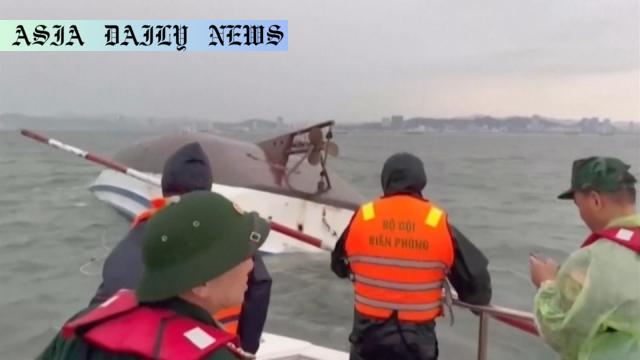Vietnam boat capsized: A tourist boat with 53 people capsized in Ha Long Bay, killing 34, leaving 8 missing, amidst rough weather conditions.

Tragic Accident in Vietnam’s Ha Long Bay
Ha Long Bay, a UNESCO World Heritage site known for its stunning emerald waters and towering limestone islands, became the site of a catastrophic accident over the weekend. A tourist boat carrying 53 passengers capsized amidst rough weather conditions on Saturday, leading to the tragic loss of at least 34 lives. Local authorities reported that the accident left eight passengers still unaccounted for while 11 people were successfully rescued from the scene. Many of the deceased and missing are believed to be Vietnamese tourists.
During the time of the accident, Ha Long Bay, located in northern Vietnam, was experiencing harsh weather, including strong winds that may have contributed to the boat capsizing. The area, typically a hub of tranquility offering serene cruises, turned chaotic as search and rescue teams scrambled to recover passengers and ensure survivors’ safety. The local government has since launched an investigation to determine the exact cause of the incident while rescue efforts continue tirelessly to locate the missing individuals.
Factors That Contributed to the Tragedy
More details are emerging about the circumstances surrounding this tragic accident. Weather in Ha Long Bay frequently fluctuates, with strong winds and sudden storms posing challenges for boating operations. Despite known risks, a comprehensive safety protocol or equipment malfunction could significantly exacerbate the situation. The tourist boat, laden with passengers, was likely navigating through adverse conditions when it overturned. Initial reports suggest that the high winds may have caused instability, and local authorities are examining whether technical or human errors contributed further to this calamity.
Alongside weather issues, overcrowding or the boat’s mechanical condition may also have played a role. Vietnam, which heavily promotes its tourism industry, mandates strict safety standards for such operations. However, lapses can occur, particularly in rural or highly trafficked areas. The investigation is expected to shed light on whether all safety regulations were followed during the operation of this vessel.
A National and Global Impact
The tragedy has shaken Vietnam and the local tourism industry surrounding Ha Long Bay. As one of the country’s most iconic travel destinations, Ha Long Bay draws millions of tourists each year. Such an incident not only devastates the families involved but also sends ripples of concern through the global travel community. Authorities are now under pressure to reassure future tourists of their strict adherence to safety protocols.
Globally, this tragedy highlights broader issues within the tourism and maritime industries, including the effects of climate change on weather patterns and the importance of rigorous safety enforcement. Lives lost in preventable disasters continue to serve as reminders of the need for vigilance, preparation, and accountability in every operation involving human lives.
In the long term, both local and international stakeholders will likely urge for a comprehensive evaluation of maritime safety practices to ensure this tragedy does not repeat itself. From implementing stricter inspection policies to investing in advanced weather prediction systems, urgent action is needed to preserve lives and restore trust among tourists.
Commentary
Emphasizing Safety in Tourism
The recent tragedy in Ha Long Bay serves as a stark reminder of the fragility of human life and the critical need for robust safety measures in the tourism industry. With 34 lives lost and several still missing, this incident encapsulates the devastating consequences of inadequate preparations and challenging environmental conditions. It prompts reflection on the shared responsibility between governments, tourism operators, and travelers themselves to prioritize safety above all else.
As breathtaking as destinations like Ha Long Bay are, their allure should never come at the price of visitor safety. The site is renowned for its serene beauty, attracting millions of tourists from around the globe. However, this tragedy demonstrates that nature’s unpredictability must be respected and accounted for. Strong winds and rough seas are not uncommon in coastal regions, yet incidents like these suggest a lack of sufficient preventative systems. This gap underscores the urgent need for stricter operational standards, improved safety training, and enhanced maritime technology.
Lessons for the Global Maritime Industry
On a global scale, the capsizing of the Vietnam tourist boat speaks to an industry-wide issue. As climate change continues to alter weather patterns making conditions like sudden storms more common, the maritime sector must adapt accordingly. Investments in weather prediction technology, reinforced vessel designs, and standardized safety regulations could significantly mitigate risks. Moreover, governments and international organizations must hold operators accountable for lapses that lead to tragedies like this.
Beyond the immediate regulatory changes, this incident calls for a cultural shift within the tourism industry. Operators must be willing to prioritize passenger safety—even if it means limiting capacity or canceling trips under adverse conditions. Tourists, too, should be encouraged to prioritize their well-being over adventurous pursuits during extreme weather scenarios.
Ultimately, while this tragic event leaves an indelible mark on the families and friends of the victims, it also serves as a sobering call to action. By fostering a culture of safety, accountability, and preparedness, the global community can honor the lives lost while striving to prevent future losses.


